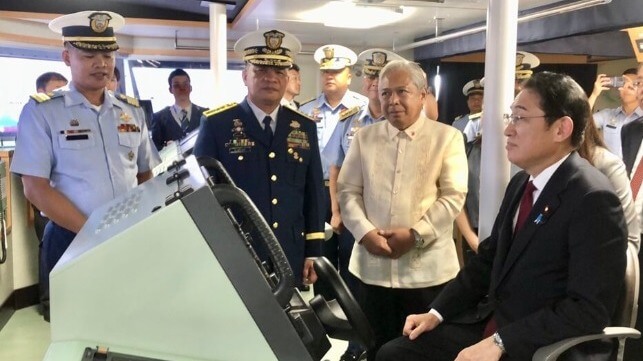Tokyo and Manila Strengthen Ties Amidst Maritime Competition with China

China’s rising assertiveness in the South China Sea is prompting a visible geopolitical realignment. On Friday, Japanese Prime Minister Fumio Kishida arrived in Philippines for a two-day visit, and the deals that followed showed a shared agreement between the two countries to offset China’s assertiveness. Japan is also embroiled in a maritime dispute with China in the East China Sea.
“We shared serious concerns about the situation in the East China Sea and the South China Sea and that attempt to unilaterally change the status quo by force is unacceptable,” Kishida said in a joint press conference on Friday with Philippine President Ferdinand Marcos Jr.
After a 90-minute meeting between the two leaders in Manila, Kishida pledged to give the Philippines a set of coastal radar systems worth $4 million. Japan will provide the radars under its new defense cooperation framework, the Overseas Security Assistance (OSA), which its Ministry of Foreign Affairs launched early this year.
As the security situation the Indo-Pacific evolves, Japan has called for a rapid build-up of its military, marking a departure from the pacifist defense strategy that it adopted after World War Two. This has also included frameworks such as OSA to allow Japanese government to provide military support to other ‘like-minded’ countries.
The Philippines is the first country to benefit from OSA. The radars will help boost maritime domain awareness in the Philippines’ EEZ, as well as to monitor Chinese activity in disputed areas of the South China Sea.
Japan has a rich history of defense cooperation with Philippines, providing a dozen patrol ships in recent years. In fact, one of the two biggest patrol ships in the Philippines’ Coast Guard is the 97-meter long Japanese-built BRP Teresa Magbanua. The Coast Guard frequently uses the vessel for sovereignty patrols and military resupply missions in the contested regions of the South China Sea. Kishida personally visited the Magbanua during his recent trip.
Kishida’s visit also launched the start of negotiations for a defense pact on reciprocal access. This will streamline joint military drills between Japan and the Philippines, and will facilitate access to military bases for the forces of the two countries. The Philippines has similar agreements with the governments of the U.S. and Australia, as well as a long-term overseas basing arrangement with the U.S. military.
The Philippines recently suspended its military exchange program with China following an increase in incidents of maritime confrontation in the Spratly Islands. The China Coast Guard and Chinese maritime militia have repeatedly harassed Philippine ships in the South China Sea, particularly the regular supply convoys to Philippine-occupied Second Thomas Shoal.
Meanwhile, reports are also emerging that the Philippines is likely to terminate China’s Belt and Road Initiative projects in the country. The Transportation Secretary Jaime Batista has already announced the scrapping of $4.9 billion worth of China’s mega-infrastructure projects in the Philippines, and Manila will look at Western and Japanese financing options for development projects instead, according to a report by the Asia Times.
Some of the major projects likely to be affected include two railway lines designed to provide hinterland connectivity on the island of Luzon and on the southern island of Mindanao.
The Philippine Senate is said to be in support of the move, and nearly all of China’s key investment initiatives in the Philippines are now in doubt, both for economic and political reasons.
